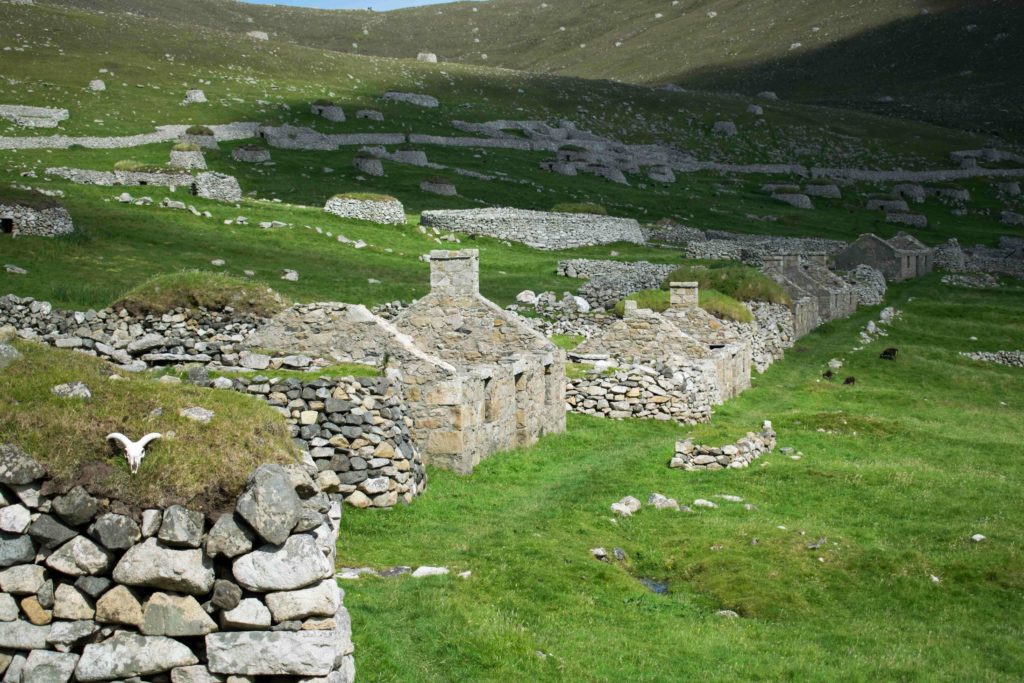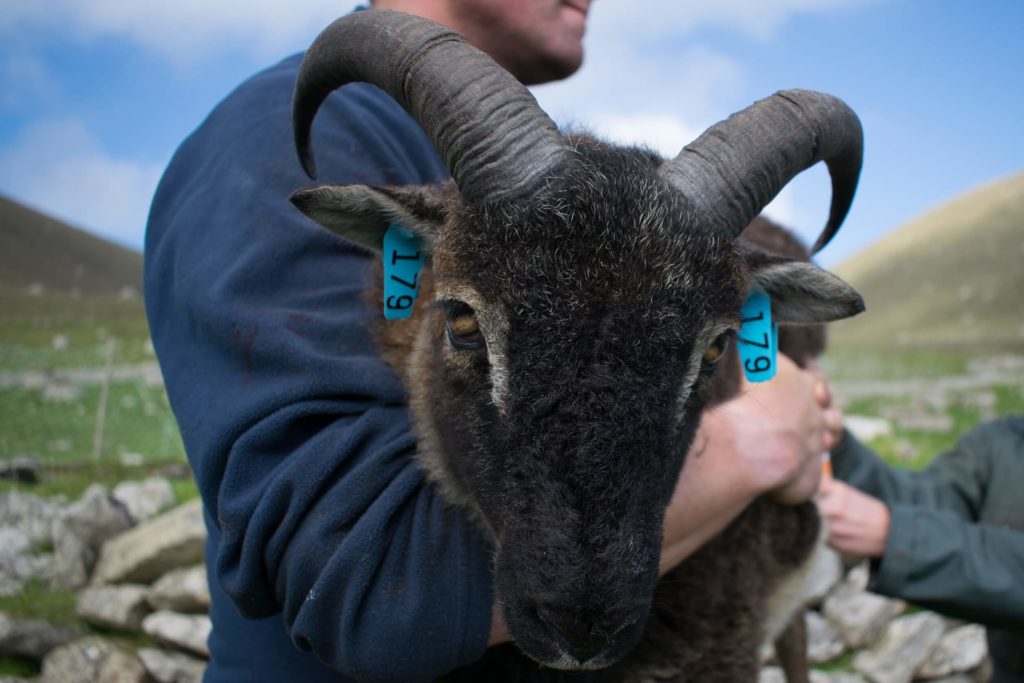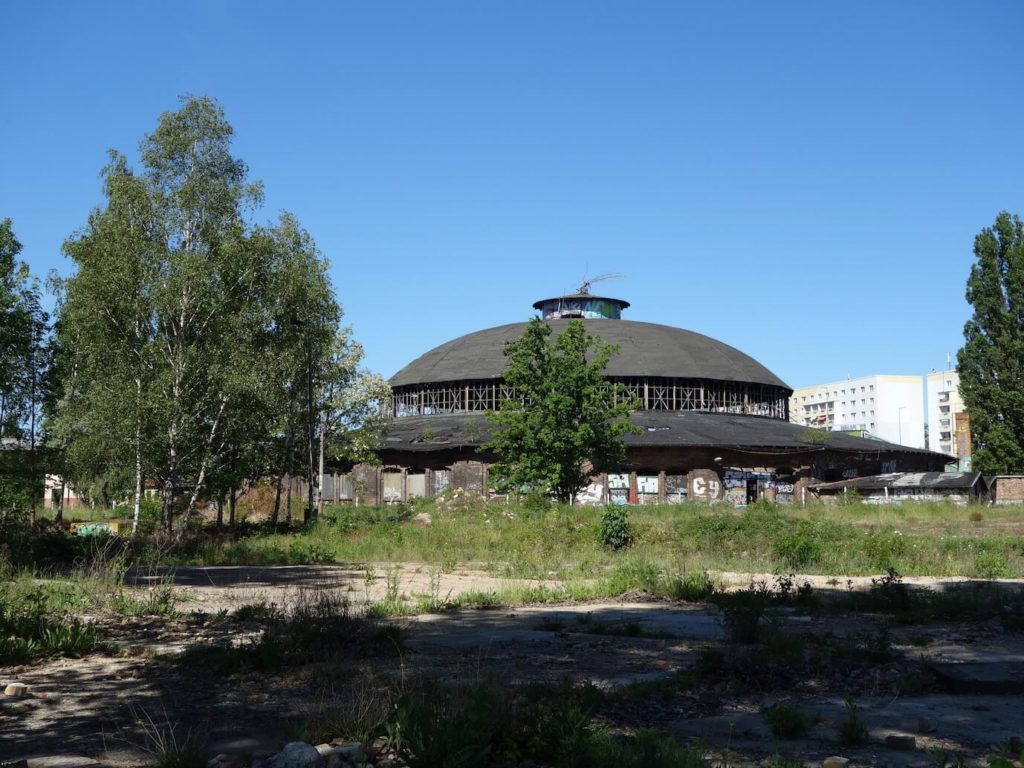Ecologies of emptiness
DOI: 10.60650/EMPTINESS-PPQT-PC51
How can scholars theorise emptiness across species, spaces, scales, and causal agents? This is the question we are seeking to answer in this collaborative project, which draws on three contrasting case studies to conceptualise the more-than-human aspects of emptiness and emptying: the Chernobyl Exclusion Zone in Ukraine; the St. Kilda archipelago in the Northern Atlantic; urban marginal spaces in Berlin.
The production of emptiness has been integral to the way capital produces space. Attending to emptiness often involves focusing on the sidelined social configurations of individuals and processes that are generally constituent in modernisation (Dzenovska 2020). By developing a more-than-human lens in relation to scholarship on emptiness, we hope to remain attentive to these sidelined human populations whilst situating them alongside the other-than-human beings who also experience, and are constitutive of, processes of emptying (e.g. Turnbull 2020, Jasper 2020, Henig 2020, Mathur 2020). Emptiness, for us, figures as a process that is always and necessarily ecological from the outset. Moreover, we posit that various kinds of empty spaces have important epistemological consequences for understanding ecology itself. In this blog, we introduce our three case studies.
Chernobyl Exclusion Zone, Ukraine
The Chernobyl Exclusion Zone (CEZ) was evacuated following the world’s worst nuclear disaster in 1986. Covering an area of approximately 2,600 square km (or 1,000 square miles), ‘the Zone’ spans northern Ukraine and southern Belarus and is in the heart of the Polissya region. Around 116,000 people were evacuated from the area following the catastrophe, which occurred at 1:23am on 26 April 1986.
The CEZ is not entirely empty. Around 2,000 workers commute to industrial sites across the Zone each day and are involved in the ongoing process of decommissioning the exploded nuclear reactor, storing old nuclear waste, and maintenance of various facilities. There are also around 100 self-settlers – samosely in Ukrainian – who either refused to leave the area during the original evacuation or who illegally resettled once the exclusion zone was implemented. Thousands of tourists visit the Zone every year, and a range of scientists conduct studies into the continuing effects of radiation on the environment.

Whilst the Zone was forcefully emptied of most of its agricultural animals, pets, and any wild animals that were in shooting range of the soldiers during the evacuation, today Chernobyl has come to be widely known as a post-apocalyptic wilderness reserve – an accidental experiment in rewilding. In 1988, the Belarusian part of the Zone was officially designated as the Polesie State Radioecological Reserve. And in 2016, the Ukrainian authorities designated the Zone as the Chernobyl Radiation and Environmental Biosphere Reserve.
Like other exclusion zones or no man’s lands, the CEZ raises questions regarding nature’s capacity to resurge in the absence of humanity. As the anniversary of the disaster passes each April, new stories continually emerge that tell of “nature’s return to Chernobyl”. Wolves, bears, wild (Przewalski’s) horses, lynx, bison, deer, beavers…the list goes on and on. Even David Attenborough got in on the act, visiting the Zone for his latest TV series A Life on Our Planet to discuss the effects that a slowdown in human activity can have on nature. Emptying, it seems, is thoroughly more-than-human.
But whilst these hopeful stories of nature’s resurgence hit the press each year, the scientific community does not agree on the state of Chernobyl’s ecosystem and the health of nature in the CEZ. In fact, an intense scientific controversy remains as to the legacy of radioactive contamination in the environment. One side of the debate suggests that radiation-induced damage can be found under every stone you turn over (see Brown 2019, Mousseau 2016), whilst the other side suggests that wildlife is now abundant, healthy, and thriving in the Zone (see Oriazola 2019). During JT’s fieldwork in the Zone, it was common to hear people suggest that “humans are worse for nature than radiation.” The necessary emptying of spaces due to industrial accidents and pollution events pose provocative questions concerning ecologies of emptiness. Emptying is framed in positive terms in relation to nature by some at Chernobyl – as freed from the ravages of human industry and exploitation. By others, the human traces left behind literally and metaphorically taint the capacity for nature to resurge. In our project, we critically examine the relationship between emptying spaces and resurgence, considering the novel ecologies that emerge via the process of emptying.
St Kilda Archipelago, North Atlantic
St Kilda has captured the geographical imagination for centuries. The four islands – Hirta, Soay, Boreray, and Dun – and accompanying sea-stacks lie some 160km West of the mainland. Its popularisation in Britain is often attributed to the travel accounts of medieval explorers and bourgeoisie Victorians (MacDonald 2001). Its dramatic landscapes, seclusion, and a cultural fascination with the story of its 1930 abandonment have inspired an extensive literature for an archipelago of its size. After centuries of habitation, the last St Kildans voted unanimously to move to the Scottish mainland, and the houses along Village Bay were left in disrepair.

Visit any bookshop in Scotland and you’ll find something on the isles, most probably Charles MacLean’s (1972) Island on the Edge of the World or Tom Steel’s (1975) The Life and Death of St Kilda. These anthropocentric accounts are steeped in ‘wilderness’ thought and romantic visions of Edenic nature, and are – frankly – factually incorrect. Emptiness on St Kilda is produced to cater to the tourist gaze and cultural imagination of an island thought to have been ‘on the edge of the world’ for centuries. During the summer, when the Atlantic Ocean is at its most calm, tourists scramble to reserve places on the two boats which offer daily trips from the Outer Hebrides to St Kilda. After the four-hour journey, tourists have around two hours on the island of Hirta before making the return trip.
Common accounts of St Kilda often fail to acknowledge its repurposing in 1957 by the military. Fraser MacDonald (2013) notes that “the tracking station for the world’s first nuclear missile unsettles the wilderness ideal” embodied in interpretations of St Kilda that tend to favour the symbolic imagery of ‘a land lost in time’ over a working barracks. Following a botanical excursion in 1931, the Earl of Dumfries feared the island would become overgrown and unkept without the presence of animals as the St Kildans had taken their agricultural animals with them. He paid three St Kildans £20 each to return to the isles to transfer 107 purebred sheep from the island of Soay (old Norse for ‘sheep island’) to Hirta to establish a viable population. Since 1953, these sheep have been the subject of one of Europe’s longest running ecological research projects, the St Kilda Soay Sheep Project. Often cited as the only living remnant of pre-Bronze Age Britain, Soay sheep are referred to as “the oldest and best-preserved cultural artefact in Scotland” by the National Trust; they are the closest living animals to pre-domesticated sheep.

In this case, we examine how emptiness is deliberately produced in St Kilda, along with the apparent ‘wilderness’ of the archipelago as a field site, to accommodate certain forms of ecological research by certain epistemic communities. In particular, we attend to the specific properties of islands as natural laboratories, in which emptiness can be monitored, governed, and commodified.
Urban marginal spaces, Berlin
Berlin has been a focal point for preoccupations with emptiness, from engagements with the city as a ‘post-traumatic space’ to the erasure of Berlin’s socialist past (e.g. Huyssen 1997). The idea of ‘empty space’ is challenged by cultural geographers who study artistic and activist appropriations of ruins, wastelands, vacant houses, and abandoned factories, conceptualising them, instead, as ‘interim spaces’ (Till 2011) or ‘makeshift urbanism’ (Vaseduvan 2015). Many activist groups in Berlin have laboured ardently to preserve marginal spaces for their essential ecological and cultural roles, often against corporate and municipal interests. Such interests can obliterate the complexity of marginal spaces in order to actively ‘discover’ or produce emptiness in pursuit of profit (Harms 2014). Thus, what is framed as emptiness can constitute the material grounds for re-imagining and building alternative urban futures. Marginal spaces reflect a counter-aesthetic of urban life that cannot be fully exhausted by capitalism.
Spontaneous appropriations of urban space are not restricted to human activities. Urban marginal spaces have sparked a renewed interest in the production of various knowledges about spontaneous urban nature (Gandy 2013 and 2016, Lachmund 2013). The field of urban ecology itself was born in the aftermath of World War Two when ecologists researched ostensibly empty spaces, finding that nature does not return to its pre-disturbance form. Rather, radically different, sometimes unknown natures emerge in the substrate of ash and rubble.
In recent years, as financial interests in Berlin intensify, the protection of marginal spaces as ecological refugia and spaces for public life is becoming increasingly difficult. Berlin’s abandoned railway yards are a case in point (Jasper, forthcoming). In Berlin’s suburbs, the former Schöneweide railway yard has developed into a 40-hectare ecological experiment. Among the many species that have found a habitat in the grasslands growing between the tracks are the sand lizard (Lacerta agilis), insects such as the blue-winged grasshopper (Oedipoda caerulescens), and the swallowtail (Papilio machaon). Over the past 20 years, a new urban biotope has emerged in a site marked by decades of infrastructural use.

Similarly, a former freight yard in northern Berlin now harbours many species including Berlin’s last natterjack toads (Bufo calamita), discovered by accident through their distinctive calls. While the Schöneweide railway yard is already being developed into a commercial zone, the development of the Pankow site has stalled, partly because of the discovery of this rare amphibian that is legally protected by nature conservation law and now enters urban politics by interrupting the speed of development.

Ecologies of emptiness engender novel sensorial experiences for humans and nonhumans. Geographers have contributed to this work by grounding landscape in the scale of human experience, for example through listening (Gallagher et al. 2017). Urban marginal spaces can function as ‘sonic refugia’ for humans and nonhumans alike; breathing spaces from the sensorial intensities of urban life (Jasper 2018). Through this case, we explore how ecologies of emptiness pose questions at the corporeal scale: can these sensibilities expand knowledges and experiences of emptiness by pointing beyond human-centric accounts?
***
In this shared project, we draw together disparate literatures concerning resurgence, marginal spaces, and emptiness in cultural geography and anthropology to advance a typology for understanding ecologies of emptiness across species, spaces, scales, and causal agents.
This is an Open Access article, distributed under the terms of the CC-BY (Creative Commons Attribution 4.0 International) licence, which permits unrestricted re-use, distribution, and reproduction in any medium, provided the original work is properly cited.